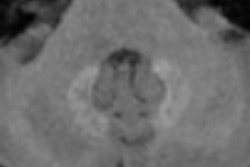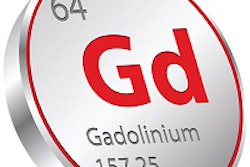Researchers from Emory University found no incidence of nephrogenic systemic fibrosis (NSF) using gadobenate dimeglumine MR contrast media in renal-failure patients after more than two years of follow-up, according to a study published in the September issue of Radiology.
The data suggest that gadobenate dimeglumine, marketed by Bracco as MultiHance, "may be safe in patients with impaired renal function, including those undergoing peritoneal dialysis, hemodialysis, or no dialysis," the authors wrote.
The study follows research from the University of Pittsburgh Medical Center (UPMC) that tracked adverse events related to gadobenate dimeglumine over a 7.5-year period. That study reported an adverse and allergic reaction rate of 0.18%, with only slightly more than half of the reported incidents requiring treatment and a handful of cases considered serious.
Concern over the long-term effects of gadolinium-based contrast agents (GBCAs) was recently rekindled after several studies reported traces of gadolinium in the brains of some patients years after they received MRI scans.
The issue of NSF and GBCAs goes back to the past decade, when studies linked NSF to patients with insufficient renal function. NSF is a debilitating and occasionally fatal disease that can include fibrosis of the bones, kidneys, lungs, muscles, myocardium, pericardium, pleura, and testes.
"Our work contributes to a growing body of literature that allows for a more comprehensive understanding of the safety profiles of different GBCAs and the risk of NSF," wrote lead author Dr. Sadhna Nandwana and colleagues from Emory's department of radiology (Radiology, September 2015, Vol. 26:3, pp. 741-747).
GBCA preference
Emory University switched from gadodiamide (Omniscan, GE Healthcare) to gadobenate dimeglumine in 2007 following reports of patients developing NSF after receiving gadodiamide, the authors wrote. Subsequent studies have reported no incidents of NSF with gadobenate dimeglumine, including in patients with renal failure, they added.
"However, weighing the benefit of obtaining diagnostic information against the risk of developing NSF can be challenging, especially since there is sparse published literature to adequately quantify the actual risk of NSF in patients with renal failure," they wrote.
Emory routinely uses contrast-enhanced MRI and MR angiography of the abdomen and pelvis for patients with end-stage renal disease to screen for malignancy and other vascular abnormalities to determine if these patients are candidates for a transplant.
Gadobenate dimeglumine is administered at a rate of 0.05 mmol/kg of body weight for MRI scans and 0.10 mmol/kg for MR angiography of the abdomen and pelvis.
Using the radiology report database in their department, the researchers identified 573 patients who received gadobenate dimeglumine for renal transplant evaluation or end-stage renal disease in 2010. Additional contrast-enhanced MRI scans between 2007 and 2014 of any body part were also noted for each patient.
After 172 patients were excluded due to insufficient follow-up, the final cohort included 229 men and 172 women with a mean age of 50 years (range, 18-77 years). Of these subjects, 303 (75%) were on dialysis. Among the 98 nondialysis individuals, 94 had chronic renal failure and four had acute renal failure.
Incidence of NSF
To prevent NSF in patients with renal function deficiencies, imaging facilities and radiology departments have implemented protocols to avoid GBCAs for individuals with an estimated glomerular filtration rate (eGFR) of less than 30 mL/min/1.73 m2.
In the current study, the 98 patients not receiving dialysis had a mean eGFR of 17 mL/min/1.73 m2. Of these subjects, 91 (93%) had an eGFR of less than 30 mL/min/1.73 m2; eGFR is not applicable to the 303 patients undergoing dialysis.
Despite the lower eGFR, there were no incidents of NSF among the 98 nondialysis patients with impaired renal function, and there were no cases of NSF among the 303 people who were receiving dialysis.
The absence of NSF continued for a mean follow-up of more than two years based on a skin examination of the patients and a mean follow-up of more than three years based on direct communication with patients.
Among the 401 patients, 126 (31%) went on to receive a renal transplant, with a mean time to transplantation of 1.72 years.
Of the 126 transplant recipients, 65 (52%) were undergoing hemodialysis, 24 (19%) were receiving peritoneal dialysis, and 37 (29%) did not have dialysis prior to their transplant.
"Our study provides some reassurance regarding the safety of gadobenate dimeglumine in individuals with renal failure, since we found a 0% incidence of NSF in 401 patients after a mean of more than two years of follow-up," the authors wrote.
The results are in line with previous research, "although the duration of follow-up in our study was longer than that in prior studies and [our study] had a larger patient cohort," Nandwana and colleagues added.



















